The Schwalm whitework is worked on densely woven (high thread count even-weave) linen. The pattern areas are filled with counted-thread embroidery and bound by other, non-counted embroidery stitches. The embroidery is worked in a variety of specific techniques and combinations: surface, drawn and cut work.
Many different large motifs of simple figures (tulip, heart, circle and bird) are always outlined with Coral Knots, Chain stitches and sometimes additional ornamental stitches. The motifs are then filled in with a wide variety of drawn thread stitches.
Open areas between the large motifs are filled with tendrils usually stitched in Coral Knots, small leaves and sometimes also small flowers are worked in Satin stitches or Blanket stitches.
Edges are decorated by various hems; Four-Sided Stitch Hem, Peahole Hem and Needleweaving Hem are of the utmost importance.
Needle Lace is used to fill areas of circles as well as for decorating edges.
Also the Schwalm Crowns are a worldwide specialty, they are not available in this form anywhere else.
With Schwalm crowns the Schwalm country women “crowned” their splendid Whitework. Usually the name of the owner, and sometimes the year, was also embroidered on the linen.
Linen
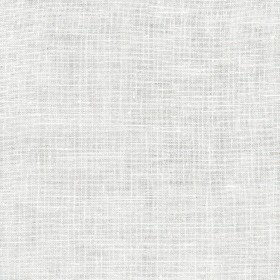 You should use only 100% linen because cotton fabric will deteriorate more quickly and your time and efforts deserve the very best fabric.
You should use only 100% linen because cotton fabric will deteriorate more quickly and your time and efforts deserve the very best fabric.
Even-weave linen is fabric that has the same number of horizontal (weft) and vertical (warp) threads over a given measurement. If linen is not even-weave, you will get a different appearance of the embroidery.
For even-weave linen, thread count means the number of threads per 1 cm (1 inch = 2.5 cm). The higher the thread count, the finer the linen and the finer the filling patterns will be.
Use linen with a thread count between 14 and 20 per cm (35 and 50 per in.).
Count threads by inserting a pin on any place of fabric parallel to fabric thread. From this pin measure up exactly 1 cm and insert another pin.
Now count the fabric threads between the pins.
To verify, do it again on another place of the fabric.
Once you verify the count of the horizontal threads, verify the count of the vertical threads.
Designs
The charm of this embroidery originates from the combination of different techniques on the one hand and from the nearly inexhaustible choice of various filling patterns one can arrange in any number and any combination into the designs on the other hand.
These pattern areas of Schwalm Whitework are filled in with counted-thread embroidery and bound by other, non-counted embroidery stitches.
This contrast between precision work and creative freestyle gives aesthetic excitement to the designs.
One can arrange design elements in different ways again and again. Always one design must have several different motifs.
The infinite variety of filling patterns makes this technique attractive and never boring to work.
In actuality, there are only ten different basic stitches in Schwalm Whitework. By modification and the combination of two or more stitches one can always find other patterns.
Years ago I started to collect and catalogue patterns. To date, I have documented more than 1000 patterns. However there are always “new” ones to discover.
Working the outlines
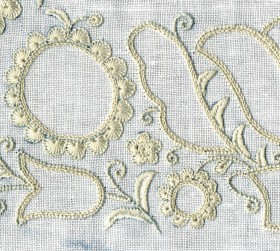 All stems and tendrils and the outlines of the motifs which will be filled later with patterns are worked with Coral Knots. Abutting the Coral Knots, inside an outlined motif, is a row of Chain stitches. And sometimes, abutting the Coral Knots, outside an outlined motif, are other ornamental stitches.
All stems and tendrils and the outlines of the motifs which will be filled later with patterns are worked with Coral Knots. Abutting the Coral Knots, inside an outlined motif, is a row of Chain stitches. And sometimes, abutting the Coral Knots, outside an outlined motif, are other ornamental stitches.
Leaves or small flowers are worked with Satin stitches or Blanket stitches.
Filling patterns
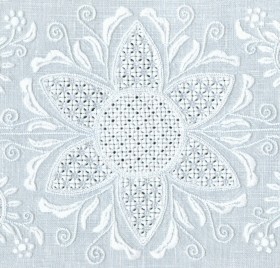 The areas of the motifs are decorated with different patterns – here: Limet patterns. For loosening fabric weave, threads are drawn out from the areas within the motifs. There are three different types of filling patterns:
The areas of the motifs are decorated with different patterns – here: Limet patterns. For loosening fabric weave, threads are drawn out from the areas within the motifs. There are three different types of filling patterns:
Simple patterns: Fabric threads are withdrawn only in one direction.
Limet patterns: Fabric threads are withdrawn in both directions. More threads remain than are withdrawn.
Openwork patterns: Fabric threads are withdrawn in both directions. The same number of threads remains as are withdrawn.
Simple drawn thread patterns
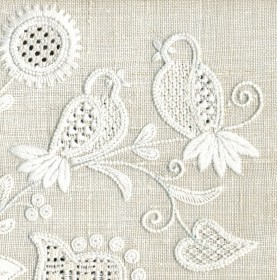 Simple patterns: Fabric threads are withdrawn only in one direction. This is for loosening fabric weave on the one hand and for easier counting on the other hand.
Simple patterns: Fabric threads are withdrawn only in one direction. This is for loosening fabric weave on the one hand and for easier counting on the other hand.
Into these areas Wave stitches (here: in the tummy of the birds) and Honeycomb Darning stitches (here: in the heart-shaped leaf) are embroidered.
Limet patterns
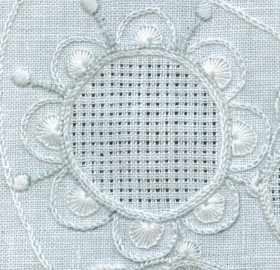 Limet patterns: The area to be covered is first divided up into squares, that means, each fourth thread lengthwise and crosswise are withdrawn (sometimes each 5th). This drawn thread grid is filled in with Diagonal Cross Filling, Four-Sided stitch, various Rose stitch/Greek Cross stitch patterns, many different Satin stitch patterns, Square Eyelet patterns or a combination of all these limet patterns.
Limet patterns: The area to be covered is first divided up into squares, that means, each fourth thread lengthwise and crosswise are withdrawn (sometimes each 5th). This drawn thread grid is filled in with Diagonal Cross Filling, Four-Sided stitch, various Rose stitch/Greek Cross stitch patterns, many different Satin stitch patterns, Square Eyelet patterns or a combination of all these limet patterns.
The word “limet” comes from Latin (limes, limitis) which means having to do with boundaries, surveying and division of plots.
Openwork patterns
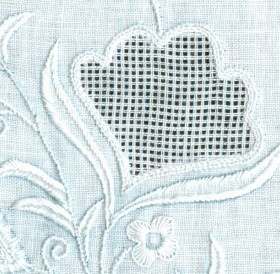 Openwork patterns: Make a grid by cutting and withdrawing two and leaving two both lengthwise and crosswise; the fabric gets transparent. The remaining pairs of thread are whipped together by Cable stitch or Reverse Faggot. Needleweaving stitches, Rose stitches (Greek Cross stitches) or a combination of both is worked into this grid.
Openwork patterns: Make a grid by cutting and withdrawing two and leaving two both lengthwise and crosswise; the fabric gets transparent. The remaining pairs of thread are whipped together by Cable stitch or Reverse Faggot. Needleweaving stitches, Rose stitches (Greek Cross stitches) or a combination of both is worked into this grid.
Spaces
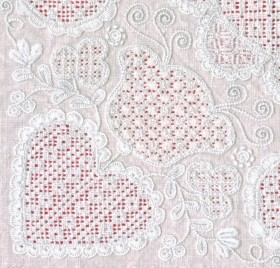 Open areas between the large motifs are filled with tendrils usually stitched in Coral Knots, small leaves and sometimes also small flowers are worked in Satin stitches or Blanket stitches.
Open areas between the large motifs are filled with tendrils usually stitched in Coral Knots, small leaves and sometimes also small flowers are worked in Satin stitches or Blanket stitches.
Edge decorations
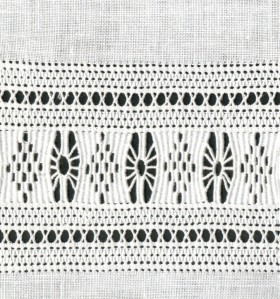 Edges are decorated by various hems; Four-Sided Stitch Hem, Peahole Hem and Needleweaving Hem are of the utmost importance.
Edges are decorated by various hems; Four-Sided Stitch Hem, Peahole Hem and Needleweaving Hem are of the utmost importance.
Sometimes these single elements are combined. Shown here is a hem decoration consisting of Four-Sided stitches, Wave stitches, Peahole hem and Needleweaving bands with spider legs.
Schwalm Crowns
Crowns are about palm-size, and often the overall shape is that of a half circle containing variants of tree-of-life or triple-shoot designs. They are usually densely ornamented. The many different designs are of extraordinary creativity and show a strong sense of aesthetics. There are crowns with “heavy” as well as filigree elements; some crowns are worked with a single design element only, and others contain all the typical Schwalm crown motifs.
Schwalm Crowns are found on bed coverings and parade cushions, on door hangings, baby slings, christening cloths, on mostly blue women´s bodices, selsom also on bodice jackets, on cloths and handkerchiefs for the Lord´s Supper masses, and on shirts for grooms.
In the beginning the crowns in the Schwalm were stitched with black thread. Black not only signified mourning, but also pride!
At the time the threads were not colourfast, and so they faded to a warm golden tone after launderings. So it came about, when colourfast threads became available, that people used a golden tone thread to stitch their crowns. So the predominate crown colours on historical Schwalm Whitework are shades of gold and brown.
There are also a couple examples of vibrant red embroidered crowns. Its owners wanted the embroidery to be eye-catching and ostentatious.
Only on decorative handkerchiefs and communion caps which were made of linen cambric dyed blue, the embroidered crowns are black.
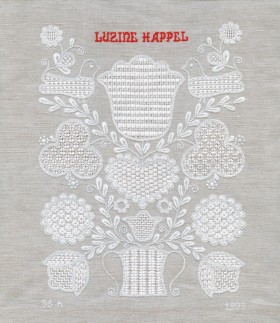
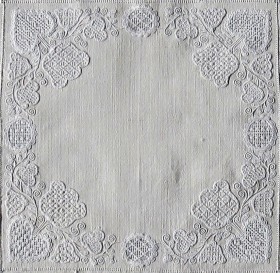
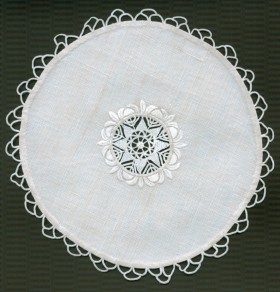
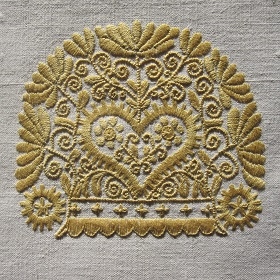
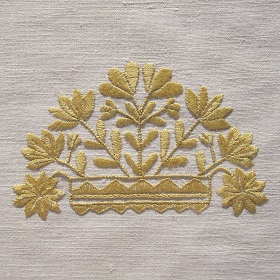


Madam,
I’m trying to create a special piece for my parent’s 50th Wedding Anniversary. My heart gravitates towards this type of embroidery. But, what really speaks to me is the book on Assisi — Unfortunately, I do not know German.
In addition, how many threads do you use ? I tried 3 and it did not look good.
We use coton à broder in 3 different thread weights. Please look here https://www.luzine-happel.de/?p=11403&lang=en